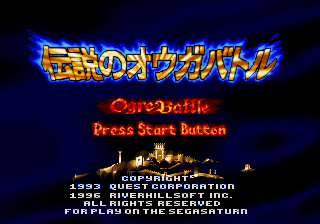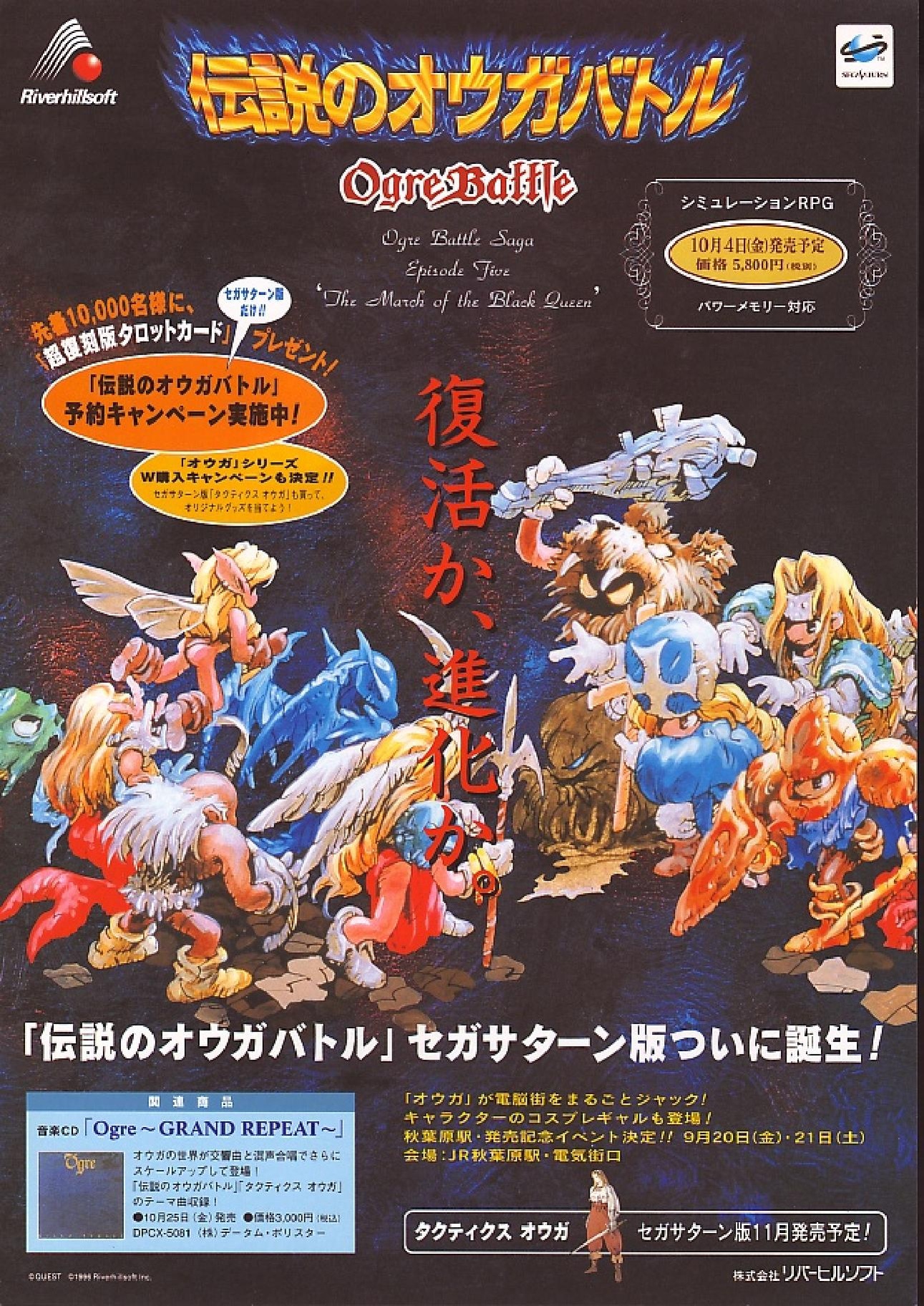Difference between revisions of "Densetsu no Ogre Battle"
From Sega Retro
Zengzidane (talk | contribs) |
|||
| Line 4: | Line 4: | ||
| developer=[[Riverhillsoft]] | | developer=[[Riverhillsoft]] | ||
| system=[[Sega Saturn]] | | system=[[Sega Saturn]] | ||
| − | |||
| sounddriver=SCSP/CD-DA (17 tracks) | | sounddriver=SCSP/CD-DA (17 tracks) | ||
| peripherals= | | peripherals= | ||
| Line 28: | Line 27: | ||
After the Empress is slain, it is discovered that she was manipulated by Rashidi, a dark wizard in the Empress’ employ. The protagonist defeats him, but before Rashidi dies, he uses his blood to release Demundza, the king of the Underworld who was sealed away after the first great Ogre Battle. The protagonist and their army manage to seal Demundza away again before he can become too powerful. There are multiple outcomes to the story depending on various factors such as the protagonist's alignment, their reputation, and which characters they choose to recruit. | After the Empress is slain, it is discovered that she was manipulated by Rashidi, a dark wizard in the Empress’ employ. The protagonist defeats him, but before Rashidi dies, he uses his blood to release Demundza, the king of the Underworld who was sealed away after the first great Ogre Battle. The protagonist and their army manage to seal Demundza away again before he can become too powerful. There are multiple outcomes to the story depending on various factors such as the protagonist's alignment, their reputation, and which characters they choose to recruit. | ||
| − | + | ==Versions== | |
| − | |||
The Saturn version of the game makes a number of additions to the SNES original, offering more frames of animation, more colours and a higher resolution. The change is less drastic than the PlayStation port which opted to re-draw the backgrounds using polygons. | The Saturn version of the game makes a number of additions to the SNES original, offering more frames of animation, more colours and a higher resolution. The change is less drastic than the PlayStation port which opted to re-draw the backgrounds using polygons. | ||
| Line 60: | Line 58: | ||
'''(C) [[Quest]]'''<br> | '''(C) [[Quest]]'''<br> | ||
'''(C) 1996 [[Riverhillsoft|Riverhillsoft Inc.]]'''<br> | '''(C) 1996 [[Riverhillsoft|Riverhillsoft Inc.]]'''<br> | ||
| − | |console=SAT | + | | console=SAT |
}} | }} | ||
}} | }} | ||
| Line 92: | Line 90: | ||
==Promotional material== | ==Promotional material== | ||
| − | |||
| − | |||
| − | |||
{{gallery | {{gallery | ||
| + | |{{gitem|DnOB Saturn JP Flyer.pdf|page=1,2|Flyer}} | ||
|{{galleryPrintAd|SSM_JP_19960712_1996-11.pdf|ssmjp|1996-11|22,23}} | |{{galleryPrintAd|SSM_JP_19960712_1996-11.pdf|ssmjp|1996-11|22,23}} | ||
|{{galleryPrintAd|SSM_JP_19960809_1996-13.pdf|ssmjp|1996-13|16,17}} | |{{galleryPrintAd|SSM_JP_19960809_1996-13.pdf|ssmjp|1996-13|16,17}} | ||
| Line 123: | Line 119: | ||
| disc=DensetsunoOgreBattle_Saturn_JP_Disc.jpg | | disc=DensetsunoOgreBattle_Saturn_JP_Disc.jpg | ||
| manual=Densetsu no Ogre Battle The March of the Black Queen JP 取扱説明書.pdf | | manual=Densetsu no Ogre Battle The March of the Black Queen JP 取扱説明書.pdf | ||
| + | }} | ||
| + | |||
| + | ==Technical information== | ||
| + | ===ROM dump status=== | ||
| + | {{romtable| | ||
| + | {{rom|SAT|sha1= |md5= |crc32= |size=505,061,424|date=1996-09-22|source=CD-ROM(JP)|comments=T-5305G V1.001|quality=good|prototype=}} | ||
}} | }} | ||
==References== | ==References== | ||
<references/> | <references/> | ||
Revision as of 11:01, 3 May 2018
| Densetsu no Ogre Battle | ||||||||||
|---|---|---|---|---|---|---|---|---|---|---|
| System(s): Sega Saturn | ||||||||||
| Publisher: Riverhillsoft | ||||||||||
| Developer: Riverhillsoft | ||||||||||
| Developer(s) of original games: Quest | ||||||||||
| Sound driver: SCSP/CD-DA (17 tracks) | ||||||||||
| Genre: Simulation | ||||||||||
| Number of players: 1 | ||||||||||
| ||||||||||
Densetsu no Ogre Battle (伝説のオウガバトル) is a 1993 strategy RPG by Quest for the SNES and the first game in their Ogre Battle series. It was ported to the Sega Saturn by Riverhillsoft in 1996. While the original SNES version and an eventual PlayStation port were released outside Japan, this port was not. One sequel, Tactics Ogre, would be ported to Saturn a month later.
Contents
Plot
Twenty-five years prior to the beginning of the game, Empress Endora conquered the continent of Zetegenia. During her reign, a resistance organization called the Liberation Army forms to free the continent from her rule.
At the beginning of the game, the protagonist, whose name, gender, and other characteristics are chosen by the player, takes command of the Liberation Army. Throughout the course of the game, the protagonist is joined by various other characters, such as Lans Hamilton, a knight who served the king of Zenobia until the king’s death; Warren Moon, a wizard with the ability to divine the future; Tristan, the rightful prince of Zenobia; and many others.
After the Empress is slain, it is discovered that she was manipulated by Rashidi, a dark wizard in the Empress’ employ. The protagonist defeats him, but before Rashidi dies, he uses his blood to release Demundza, the king of the Underworld who was sealed away after the first great Ogre Battle. The protagonist and their army manage to seal Demundza away again before he can become too powerful. There are multiple outcomes to the story depending on various factors such as the protagonist's alignment, their reputation, and which characters they choose to recruit.
Versions
The Saturn version of the game makes a number of additions to the SNES original, offering more frames of animation, more colours and a higher resolution. The change is less drastic than the PlayStation port which opted to re-draw the backgrounds using polygons.
Production credits
- Programming: Mitsuru Saito, Keiji Ohnishi, Tetsuo Niizeki, Shinobu Kobatake, Yoshio Fukushima
- Graphics: Satoshi Goto, Hiroko Iwatani
- Additional scenario: Shinta Takamura, Kazuyuki Miura
- Development support: Yasutaka Shinoda, Atsushi Fukuda
- Music: Hiroaki Iwatani, Tomohiro Akaki, Ken Inaoka
- Casting coordinate: Radon'86
- Narration director: Junko Araki (Radon'86)
- Generalization: Kenji Uga (Q-Tec)
- Recording Engineer: Keiji Aoyama (Q-Tec), Setsuo Yamai (Q-Tec)
- Voice actors: Mitsuaki Madono, Tsumugi Ohsawa, Kenyu Horiuchi, Takehito Koyasu, Eiichiro Suzuki, Taro Arakawa, Yu Hachinohe, Akio Ohtsuka, Ai Orikasa, Ryu-taro Okiayu, Jyu-rota Kosugi, Keiko Himukashi, Yo-ko Asagami, Rika Fukami, Rei Igarashi, Shigeru Nakahara, Fumihiko Tachiki, Kaori Takii
- Game Design: Yasumi Matsuno
- Programming: Nobuo Morioka, Takashi Sato, Masaya Ogawa
- Graphics: Hiroshi Minagawa, Akihiko Yoshida
- Music: Masaharu "Rezon" Iwata, Hitoshi "YmoH.S" Sakimoto, Hayato Matsuo
- Special thanks to: Kazumasa Takasaki, Yoshihiko Miyazaki, Toshihiko Ichimaru, Ryo-ichi Takeyama, Shigekazu Ueno, Shin-ichiro Kawabata, Hideaki Miyakushi, Takashi Takezawa, Shinji Tachikawa, Nobuhiro Ito (Q-Tec), Yukio Kakehi
- Production assistance: Jackpot, Quest, Q-Tec, Datam Polystar, Cybersound
- Producer: Junji Shigematsu
- Executive Producer: Kazuhiro Okazaki
Presented by: Riverhillsoft Inc.
(C) Quest
(C) 1996 Riverhillsoft Inc.
Track list
| 1. [data track] |
|---|
| 2. Kagerou (00:36) |
|---|
| EN: Schlieren |
| 3. Guerrilla War (03:33) |
|---|
| Composed by: Masaharu Iwata |
| Arranged by: Hiroaki Iwatani, Tomohiro Akaki. Ken Inaoka |
| 4. Do or Die (02:25) |
|---|
| Composed by: Masaharu Iwata |
| Arranged by: Hiroaki Iwatani, Tomohiro Akaki. Ken Inaoka |
| 5. Yabaissu (00:06) |
|---|
| EN: Rout |
| Composed by: Masaharu Iwata |
| Arranged by: Hiroaki Iwatani, Tomohiro Akaki. Ken Inaoka |
| 6. Brass of Victory (00:06) |
|---|
| Composed by: Masaharu Iwata |
| Arranged by: Hiroaki Iwatani, Tomohiro Akaki. Ken Inaoka |
| 7. Kaihou no Yorokobi (00:16) |
|---|
| EN: Level End |
| 8. Overture (01:05) |
|---|
| Composed by: Hitoshi Sakimoto |
| Arranged by: Hiroaki Iwatani, Tomohiro Akaki. Ken Inaoka |
| 9. Entrance Parade (02:59) |
|---|
| Composed by: Masaharu Iwata |
| Arranged by: Hiroaki Iwatani, Tomohiro Akaki. Ken Inaoka |
| 10. Beginning of Tale (01:45) |
|---|
| Composed by: Masaharu Iwata |
| Arranged by: Hiroaki Iwatani, Tomohiro Akaki. Ken Inaoka |
| 11. Jijii no Inori (02:13) |
|---|
| EN: Fortune Teller |
| Composed by: Hitoshi Sakimoto |
| Arranged by: Hiroaki Iwatani, Tomohiro Akaki. Ken Inaoka |
| 12. Atlas (01:43) |
|---|
| Composed by: Masaharu Iwata |
| Arranged by: Hiroaki Iwatani, Tomohiro Akaki. Ken Inaoka |
| 13. Yasuraka ni Nemure (00:25) |
|---|
| EN: Rest in Peace |
| Composed by: Masaharu Iwata |
| Arranged by: Hiroaki Iwatani, Tomohiro Akaki. Ken Inaoka |
| 14. Madoromi no Hitotoki (01:09) |
|---|
| EN: Coma |
| Composed by: Masaharu Iwata |
| Arranged by: Hiroaki Iwatani, Tomohiro Akaki. Ken Inaoka |
| 15. Wave of Darkness (03:18) |
|---|
| Composed by: Masaharu Iwata |
| Arranged by: Hiroaki Iwatani, Tomohiro Akaki. Ken Inaoka |
| 16. Morning Star (00:20) |
|---|
| Composed by: Masaharu Iwata |
| Arranged by: Hiroaki Iwatani, Tomohiro Akaki. Ken Inaoka |
| 17. Neo-Overture 1 (03:08) |
|---|
| Composed by: Hitoshi Sakimoto |
| Arranged by: Hiroaki Iwatani, Tomohiro Akaki. Ken Inaoka |
| 18. Neo-Overture 2 (02:52) |
|---|
| Composed by: Hitoshi Sakimoto |
| Arranged by: Hiroaki Iwatani, Tomohiro Akaki. Ken Inaoka |
Magazine articles
- Main article: Densetsu no Ogre Battle/Magazine articles.
Promotional material
Physical scans
| Sega Retro Average | |||||||||||||||||||||||||||||||||||||||
|---|---|---|---|---|---|---|---|---|---|---|---|---|---|---|---|---|---|---|---|---|---|---|---|---|---|---|---|---|---|---|---|---|---|---|---|---|---|---|---|
|
| 75 | |
|---|---|
| Based on 7 reviews | |
Technical information
ROM dump status
| System | Hash | Size | Build Date | Source | Comments | |||||||||
|---|---|---|---|---|---|---|---|---|---|---|---|---|---|---|
| ✔ |
|
505,061,424 | 1996-09-22 | CD-ROM(JP) | T-5305G V1.001 |
References
- ↑ File:SSM_JP_19961108_1996-19.pdf, page 232
- ↑ 2.0 2.1 Saturn no Game wa Sekai Ichi~i~i~i!: Satamaga Dokusha Race Zen Kiroku, SoftBank Publishing, page 12 Cite error: Invalid
<ref>tag; name ":File:SnGwSISDRZK Book JP.pdf_p12" defined multiple times with different content - ↑ Famitsu, "1996-11-08,15" (JP; 1996-10-25), page 1
- ↑ Joypad, "Décembre 1996" (FR; 1996-1x-xx), page 88
- ↑ Saturn Fan, "1996 No. 22" (JP; 1996-10-18), page 193
- ↑ Saturn Fan, "1996 No. 26" (JP; 1996-12-13), page 70
- ↑ Sega Saturn Magazine, "1996-19 (1996-11-08)" (JP; 1996-10-25), page 232
- ↑ Ultra Game Players, "September 1997" (US; 1997-08-19), page 83
- Pages with reference errors
- 1 player games
- JP Saturn games
- All JP games
- Saturn games
- 1996 Saturn games
- All 1996 games
- Saturn simulation games
- All simulation games
- Old content rating field
- All games
- Credits without source
- Credits without reference
- Track missing credits
- Track credits
- GalleryPrintAd file defined
- Old-style rating (famitsu)
- Rating without PDF source
- Old-style rating (ssmjp)
- Use magref
- Old-style rating (ssmjp r)
- Update ratings template
- 3 old ratings
- Missing ROM hashes
- Old technical information









